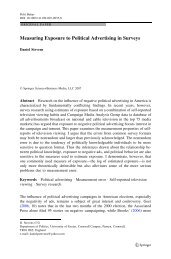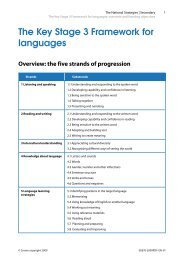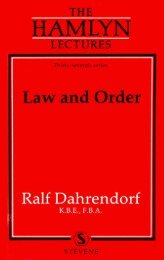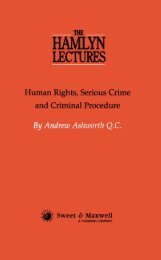Pragmatism and Theory in English Law - College of Social Sciences ...
Pragmatism and Theory in English Law - College of Social Sciences ...
Pragmatism and Theory in English Law - College of Social Sciences ...
You also want an ePaper? Increase the reach of your titles
YUMPU automatically turns print PDFs into web optimized ePapers that Google loves.
The Strengths <strong>of</strong> the Pragmatic Tradition 55<br />
sufficient to justify their conclusion, <strong>and</strong> it is noteworthy<br />
that the Northern Irel<strong>and</strong> Court <strong>of</strong> Appeal has refused to<br />
follow the <strong>English</strong> Court on this po<strong>in</strong>t. 15<br />
Rights <strong>and</strong> Remedies<br />
I turn now to say someth<strong>in</strong>g <strong>of</strong> the strengths <strong>of</strong> the <strong>English</strong><br />
legal tradition <strong>in</strong> the matter <strong>of</strong> rights <strong>and</strong> remedies. I said <strong>in</strong><br />
my first lecture that I thought there were still many respects<br />
<strong>in</strong> which our law was more remedy-oriented than rightsoriented,<br />
<strong>and</strong> I want now to give some examples <strong>of</strong> the way<br />
<strong>in</strong> which this orientation contributes to the pragmatic<br />
strength <strong>of</strong> the law.<br />
Pride <strong>of</strong> place here must go to two quite remarkable <strong>in</strong>novations<br />
which have recently been developed by the courts<br />
with respect to the use <strong>of</strong> <strong>in</strong>terlocutory <strong>in</strong>junctions, namely<br />
the Mareva <strong>in</strong>junction, <strong>and</strong> Anton Filler <strong>in</strong>junction. These<br />
<strong>in</strong>novations have certa<strong>in</strong>ly justified the remark attributed to<br />
Harman J. <strong>in</strong> 1951 that, "Equity is not to be presumed to be<br />
<strong>of</strong> an age past child-bear<strong>in</strong>g." 16 These two new types <strong>of</strong><br />
<strong>in</strong>junction are now well known to practitioners especially <strong>in</strong><br />
certa<strong>in</strong> types <strong>of</strong> commercial litigation, but they concern<br />
areas <strong>of</strong> the law with which the average student is unlikely<br />
to come <strong>in</strong>to contact. Yet they are such an <strong>in</strong>terest<strong>in</strong>g<br />
example <strong>of</strong> the practical strengths <strong>of</strong> <strong>English</strong> remedies <strong>in</strong><br />
action, that they deserve some discussion <strong>in</strong> a lecture<br />
devoted to the pragmatic strengths <strong>of</strong> the <strong>English</strong> legal tradition.<br />
Both <strong>of</strong> these developments are still very young, <strong>in</strong>deed<br />
scarcely ten years old. The Mareva <strong>in</strong>junction was orig<strong>in</strong>ally<br />
devised to deal with the situation where a potential defend-<br />
15 R. v. Governor <strong>of</strong> HM. Prison, The Maze, ex. p. McKiernan (1985), N.I.L.R.<br />
Bullet<strong>in</strong>, No. 6, 1985, p. 6; see Note <strong>in</strong> [1985] Public <strong>Law</strong> 527.<br />
16 See R. E. Megarry, (1951) 67 L.Q.R. 506.

















